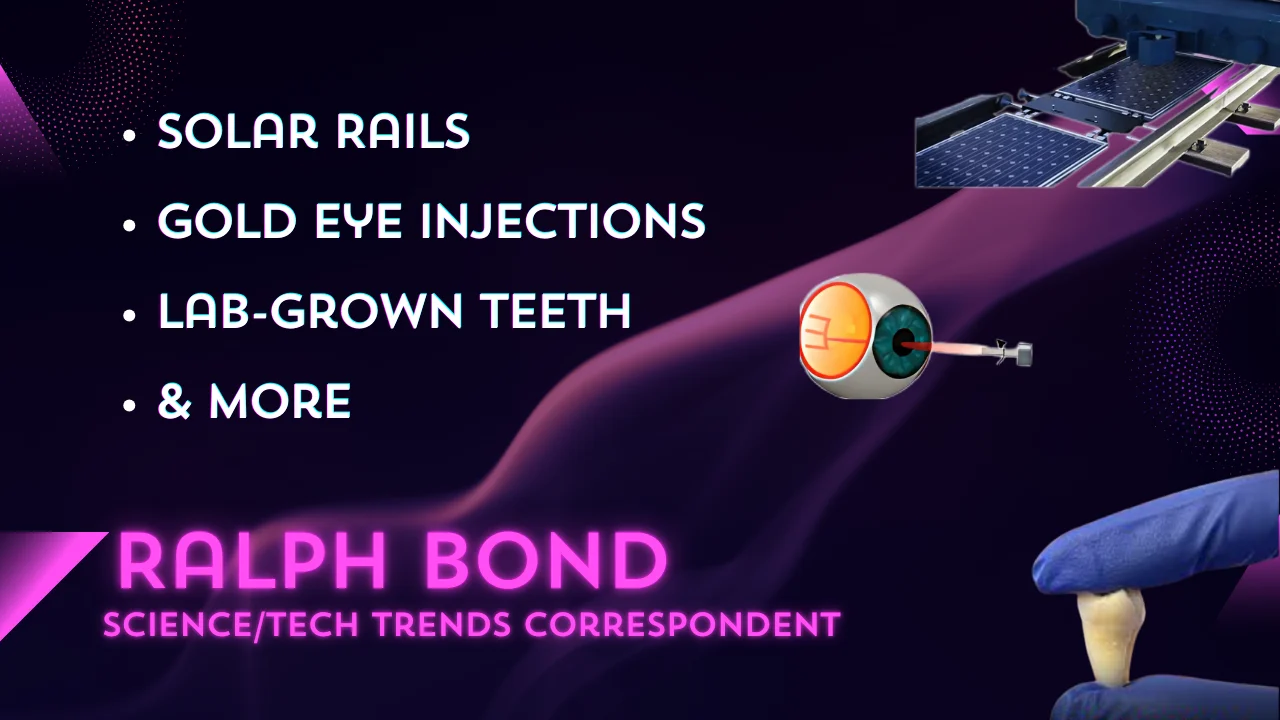
Show Notes 9 May 2025
Story 1: World’s first railway track-mounted solar plant open to rail traffic
Source: PV Magazine Story by Patrick Jowett
See research paper here: https://www.sciencedirect.com/science/article/pii/S2772671123001249#fig0002
See also: https://www.sun-ways.ch/en
- Swiss startup Sun-Ways has switched on a removable solar plant installed on a functioning railroad line in western Switzerland.
- Note – the solar panels are deposited in between the tracks of a rail line. Special rail cars deposit the panels.
- The array, billed as the world’s first track-mounted solar plant open to rail traffic, sits in the Neuchâtel mountains [in Switzerland] and includes 48 solar panels rated at 385 W each.
- The installation has a total output of 18 kW and is expected to generate 16 MWh of clean energy per year, feeding power into the public grid 500 meters from the site.
- Passenger trains began running over the test installation on April 28.
- Sun-Ways said it will carry out tests over the next three years on panel coating, soiling, and the system’s impact on rail infrastructure. The data will help determine whether rail operations can run safely with a removable solar array mounted between the tracks.
- Delegations from Belgium, France, Indonesia, Israel, and South Korea attended the inauguration to assess potential deployment in their home countries, said the company.
- Reality Check: Critics have focused on two key concerns that may limit the performance of solar panels: heavy soiling and strong mechanical stress from trains passing overhead. Both factors could significantly shorten a system’s lifespan and reduce energy output.
- My comment – why not put solar panels on the top of railway cargo cars?
Story 2: New electronic “skin” could enable lightweight night-vision glasses – MIT engineers developed ultrathin electronic films that sense heat and other signals and could reduce the bulk of conventional goggles and scopes.
Source: MIT News Story by Jennifer Chu
Link: https://news.mit.edu/2025/new-electronic-skin-could-enable-lightweight-night-vision-glasses-0423
See research paper here: https://www.nature.com/articles/s41586-025-08874-7
- MIT engineers have developed a technique to grow and peel ultrathin “skins” of electronic material. The method could pave the way for new classes of electronic devices, such as ultrathin wearable sensors, flexible transistors and computing elements, and highly sensitive and compact imaging devices.
- As a demonstration, the team fabricated a thin membrane of pyroelectric material — a class of heat-sensing material that produces an electric current in response to changes in temperature. The thinner the pyroelectric material, the better it is at sensing subtle thermal variations.
- With their new method, the team fabricated the thinnest pyroelectric membrane yet, measuring 10 nanometers thick, and demonstrated that the film is highly sensitive to heat and radiation across the far-infrared spectrum.
- The newly developed film could enable lighter, more portable, and highly accurate far-infrared (IR) sensing devices, with potential applications for night-vision eyewear and autonomous driving in foggy conditions.
- Current state-of-the-art far-IR sensors require bulky cooling elements. In contrast, the new pyroelectric thin film requires no cooling and is sensitive to much smaller changes in temperature.
- The researchers are exploring ways to incorporate the film into lighter, higher-precision night-vision glasses.
- The heat-sensing film could also have applications in environmental and biological sensing, as well as imaging of astrophysical phenomena that emit far-infrared radiation.
- What’s more, the new lift-off technique [this refers to the ability to peel the ultrathin “skins” of electronic material] is generalizable beyond pyroelectric materials. The researchers plan to apply the method to make other ultrathin, high-performance semiconducting films.
Story 3: Gold Injections in The Eye May Be the Future of Vision Preservation
Source: Science Alert Story by David Nield
Link: https://www.sciencealert.com/gold-injections-in-the-eye-may-be-the-future-of-vision-preservation
See research paper here: https://pubs.acs.org/doi/10.1021/acsnano.4c14061
- Gold dust in eyes might seem like an unusual therapy – but a new mouse study conducted at Brown University in Rhode Island shows the approach could potentially treat age-related macular degeneration (AMD) and other eye problems.
- Macular degeneration affects millions worldwide and becomes more likely as we age. Damage to the macula, located in the retina and containing light-sensitive photoreceptor cells, causes blurring and other vision issues. While there are treatments available to slow the progression of age-related macular degeneration, they don’t reverse it.
- One of the lead researchers noted, “This is a new type of retinal prosthesis that has the potential to restore vision lost to retinal degeneration without requiring any kind of complicated surgery or genetic modification”.
- Here’s how the new treatment works:
- Very fine gold nanoparticles, thousands of times thinner than a human hair, are laced with antibodies to target specific eye cells.
- They’re then injected into the gel-filled vitreous chamber between the retina and the lens.
- Next, a small infrared laser device is used to excite these nanoparticles and activate specific cells in the same way photoreceptors do.
- If the treatment makes it to us humans as well, that laser could be embedded in a pair of glasses.
- In the mice this was tested on, engineered to have retinal disorders, the treatment method was effective at restoring vision, at least partly (it’s tricky to give a mouse a full eye test). It showed the nanoparticles could help bypass damaged photoreceptors.
Story 4: Lab-grown teeth could offer an alternative to fillings and implants, scientists say
Source: Live Science Story by Jess Thomson
See research paper here: https://pubs.acs.org/doi/10.1021/acsmacrolett.4c00520
- When our teeth are damaged, dentists mend cavities with fillings or replace teeth with artificial tooth implants. However, these solutions cannot repair themselves and may need to be replaced.
- Meanwhile, tooth implants require invasive surgery, usually across multiple appointments, and can risk infection and damage to surrounding teeth and gums
- Scientists at King’s College, London have developed a new material that may allow them to grow teeth in the lab, which could provide an alternative to fillings and dental implants someday.
- The team developed a special material that allows cells to communicate with one another just as they would in the body, therefore enabling them to develop into tooth cells.
- The process allows scientists to grow teeth from a patient’s cells in the lab. Someday, it could enable damaged or infected teeth to be replaced by [a patient’s] real teeth, rather than being repaired using fillings and other dental procedures.
- For years, scientists at King’s College London have been working on a process for growing teeth, which involves mimicking how teeth grow within the body.
- Here’s how it works:
- Teeth begin growing from stem cells during early embryonic development, with stem cells from different types of embryonic tissue “talking” to each other using signaling molecules to trigger tooth formation.
- The stem cells differentiate into various forms of cells, which then secrete the materials that the tooth is eventually made from, such as enamel, dentin and cementum.
- In the new study, the researchers described how they made a crucial breakthrough by developing a material that allowed stem cells to communicate as they would in the body. The material was made from hydrogel — a soft, gel-like material that can absorb large amounts of water — and emulates the environment around the cells in the body, known as the matrix.
Honorable Mentions
Story: World’s first operating system for quantum computers unveiled — it can be used to manage a future quantum internet
Source: Live Science Story by Peter Ray Allison
See research paper here: https://www.nature.com/articles/s41586-025-08704-w
- Scientists at Delft University of Technology, Delft, the Netherlands, have developed QNodeOS, the world’s first operating system designed for quantum computers. This breakthrough allows quantum computers with different types of qubits to function together in a single network, paving the way for a quantum internet.
- Traditional quantum computers are often built for specific tasks, limiting their connectivity and functionality. QNodeOS solves this by integrating a classical network processing unit (CNPU) with a quantum network processing unit (QNPU), enabling seamless communication between different quantum machines.
- A key component of QNodeOS is the QDriver, which translates quantum operations across various hardware platforms, making it possible to control multiple quantum computers from a single system. This innovation could significantly advance quantum computing and networking capabilities.
////////////////////////////////////////////////////////////////////////////////////////////////////////////////////////////////////////////
Story: Flying robots could help construct future skyscrapers, proves live test
Source: Interesting Engineering Story by Georgina Jedikovaska
Link: https://interestingengineering.com/innovation/flying-robots-could-construct-future-skyscrapers
- UK researchers have claimed that flying robots could build skyscrapers as outstanding as the UAE’s Burj Khalifa or New York’s Empire State Building by reaching heights and locations once deemed impossible.
- The study, conducted by Imperial College London and the University of Bristol, explores how drones can perform mid-air material deposition autonomously – a process known as Aerial Additive Manufacturing (Aerial AM) – marking a significant step forward in aerial construction technology.
- According to the scientists, the technology aims to tackle urgent global housing and infrastructure challenges by using aerial robots with advanced manipulators capable of overcoming the limitations of traditional construction methods and ground-based robotics.
////////////////////////////////////////////////////////////////////////////////////////////////////////////////////////////////////////////
Story: Hydrogen Fuel Cells Power New Future for Data Centers in California
Source: Hydrogen Fuel News Story by Allen Brown
- Bloom Energy and Equinix are joining forces to push data center sustainability to the next level, rolling out hydrogen fuel cells at one of Equinix’s flagship facilities in California’s tech-heavy Bay Area. Kicking off in late 2023 and continuing through 2024, this project is putting a spotlight on how solid oxide fuel cell (SOFC) technology can play a big role in making one of the world’s most power-hungry industries a lot greener.
- Bloom Energy’s systems use solid oxide fuel cells that run super-hot — we’re talking 500°C to 1,000°C. That high temp allows for fuel flexibility. While the tech can run on natural gas or biogas, Equinix is going all-in on green hydrogen, produced by electrolysis.
- This project isn’t just some one-off experiment. It’s part of a broader movement to clean up digital infrastructure and scale up fuel cell technology. Tech giants like Microsoft and Google are already testing hydrogen fuel cells as part of their own push to ditch diesel and embrace cleaner backup systems.
- Meanwhile, the demand for low-carbon ammonia and serious investment in hydrogen infrastructure — from storage to supply — shows that governments and industries are paying close attention. Partnerships like this one prove it’s not just talk; real-world solutions are starting to land.
////////////////////////////////////////////////////////////////////////////////////////////////////////////////////////////////////////////
Story: Smart Brain Implants Can Now Adapt to Optimize Parkinson’s Treatment
Source: Science Alert Story by Vladimir Litvak
Link: https://www.sciencealert.com/smart-brain-implants-can-now-adapt-to-optimize-parkinsons-treatment
- This article discusses a breakthrough in adaptive deep brain stimulation for Parkinson’s treatment.
- Traditionally, deep brain stimulation involves constant electrical pulses to manage symptoms, but this new approach allows real-time adjustments based on brain activity.
- Scientists at University College London discovered that specific brain waves appear when symptoms worsen and disappear when medication is effective.
- This discovery led to a computer-controlled system that adjusts stimulation levels dynamically, improving symptom relief. The technology was recently approved by US and European health authorities.

